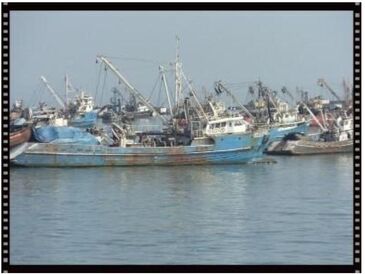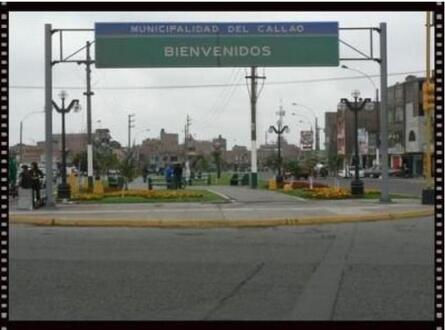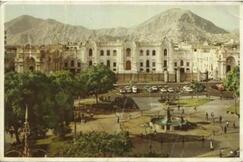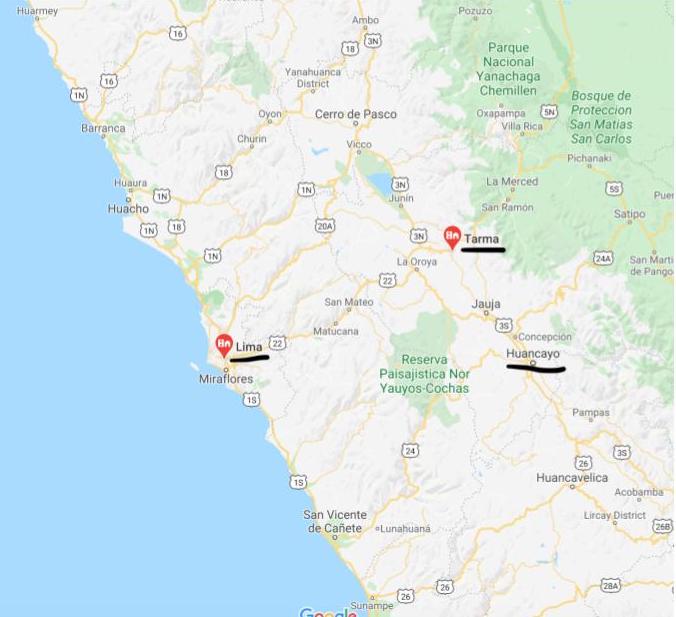Chapter 4: The First days in Lima
AS TOLD BY JOHN AGERSTEN

It was indeed a happy surprise to see the Swedish missionaries Boyan and Lennart Lindgren with their two children, and Brita and Per Andrås with three of their five children on the dock. They told us they had heard our ship had arrived a day early, and they were just wondering how to get out to our ship when we arrived on the little boat! It was so wonderful to finally meet them after having corresponded with them for some time. We were also very relieved knowing that our sea voyage was coming to an end.
We had a lovely afternoon together. They took us to a cafe where we ate and enjoyed ourselves until we had to take the small boat back to the ship for one more night on board.
Early the next morning, Wednesday, January 4th, 1967, the ship finally pulled into the dock in Callao, Lima’s port town. We had spent five weeks on board, and the “M.S. Margrethe Bakke” had proven herself a safe home across the ocean in both sunshine and storms. We were, however, ready for our adventure to continue on dry land, so we were packed and ready to disembark as soon as the gangway was out!
We had a lovely afternoon together. They took us to a cafe where we ate and enjoyed ourselves until we had to take the small boat back to the ship for one more night on board.
Early the next morning, Wednesday, January 4th, 1967, the ship finally pulled into the dock in Callao, Lima’s port town. We had spent five weeks on board, and the “M.S. Margrethe Bakke” had proven herself a safe home across the ocean in both sunshine and storms. We were, however, ready for our adventure to continue on dry land, so we were packed and ready to disembark as soon as the gangway was out!

We wrote in a letter home: "When we came down the gangway from the boat, Lennart Lindgren was standing on the pier to receive us. A little later Per Anderås came also with a couple of his older children. Everyone helped us with our luggage which went smoothly through customs. When everything was loaded into cars, we drove to the place we were going to stay while in Lima. We have to stay in Lima while all the documents for residence permits and such are being arranged. We are staying with the family Lindgren in a 2 bedroom apartment that the Methodists own. The family Anderås are vacationing here and are renting an apartment from the Scandinavian Seamen's Church."
Per and Brita Anderås were pioneer missionaries to Peru from the Swedish Pentecostal Church. They had worked five years in Chile before coming to Peru to start a ministry in Tarma, a town in the Andes Mountains. When Boyan and Lennart Lindgren arrived in Peru, they took over the work in Tarma, and the Anderås family established a new base in Huancayo. Huancayo is the capital of the rural county Junin. Tarma is also located in that county, but it takes nearly three hours to drive by car between Huancayo and Tarma, though, because the road is narrow and winding. Both cities are located at an altitude of three thousand meters on the Andean high plateau. Lennart and Boyan Lindgren were now going home to Sweden for a year after working in Peru for five years. The agreement was that we would be responsible for the ministry in Tarma while they were in Sweden. We were happy to know that we would be working with them for a couple of months in Tarma before they left. But as mentioned earlier, there were many things to take care of in Lima, before we could travel on to Tarma.
Per and Brita Anderås were pioneer missionaries to Peru from the Swedish Pentecostal Church. They had worked five years in Chile before coming to Peru to start a ministry in Tarma, a town in the Andes Mountains. When Boyan and Lennart Lindgren arrived in Peru, they took over the work in Tarma, and the Anderås family established a new base in Huancayo. Huancayo is the capital of the rural county Junin. Tarma is also located in that county, but it takes nearly three hours to drive by car between Huancayo and Tarma, though, because the road is narrow and winding. Both cities are located at an altitude of three thousand meters on the Andean high plateau. Lennart and Boyan Lindgren were now going home to Sweden for a year after working in Peru for five years. The agreement was that we would be responsible for the ministry in Tarma while they were in Sweden. We were happy to know that we would be working with them for a couple of months in Tarma before they left. But as mentioned earlier, there were many things to take care of in Lima, before we could travel on to Tarma.

Lima is the capital of Peru and is located on the desert strip between the Pacific Ocean and the Andes mountain range. In 1967, when we arrived, there were about a million inhabitants living there. The city was different from anything we were used to from Europe, so there were many impressions to take in. In the center of the city, there were beautiful, old buildings from the colonial period, and also a part with tall, modern buildings. The photo on the left is an old postcard we sent home depicting the Presidential Palace.

Around the city, there were many suburbs that clung to the mountain slopes. In these suburbs, people lived in cardboard shacks or shelters built out of whatever they could find. Very few of them had water, sewerage, or electricity. Some places we saw, they had begun to build up a wall of brick or of sun-dried blocks made of mud and straw. These suburbs, located within the Lima municipality, stood in stark contrast to the beautiful parts of the city with nice houses placed in large gardens with palm trees and tropical vegetation. There were also suburbs with single small brick houses that stood close to each other right by the streets. Most of these homes had a small courtyard inside. The contrasts were staggering!
After a few days in Lima, we got out the rest of our luggage from customs duty-free. That had been arranged well in advance. About this we wrote in a letter home:
"Wednesday, Thursday, and Friday we ran together with Per Anderås to all kinds of offices to arrange for the documents to obtain a residence permit. We had no idea that so much paperwork was needed - and so much money! We ended up spending several hundred kroner (Norwegian currency), but luckily we will be refunded from the Salem church! While we were doing this, Lennart went to the customs offices and arranged to get all our boxes. It was nice that all the duty-free papers were arranged in advance. Even so, most of the boxes had been opened for inspection. "
Friday, Lennart and I went to the port in Callao and loaded the car up with our boxes, and drove it to the train station. From there, it would go by the train that goes between Lima and Huancayo. The railway employees assured us they would take care of it and make sure it made it right up to our front door in Tarma. However, the railroad does not actually pass through Tarma on its way to Huancayo, so that made us a little nervous! Lennart assured us everything would go well, and happily, he was right! Everything arrived at Tarma on time! Now we thought everything was in place for us to leave Lima behind and drive to Tarma where the congregation was preparing a welcome for us that weekend. But we were wrong!
We continued writing in the letter:
"Friday papers were delivered to us from a mandatory medical examination at the immigration office and we were told to come again next week to have our fingerprints taken. At that time, they would also take some photographs of us with a number over our heads. Well, all we could do was to plan on a brief visit to Tarma with a return trip to Lima after the weekend. "
Even if it would be a quick trip, we were really looking forward to traveling to Tarma and seeing the place where we would be working and the people we would be working with. Lima, we will see you again soon. Tarma, here we come!
